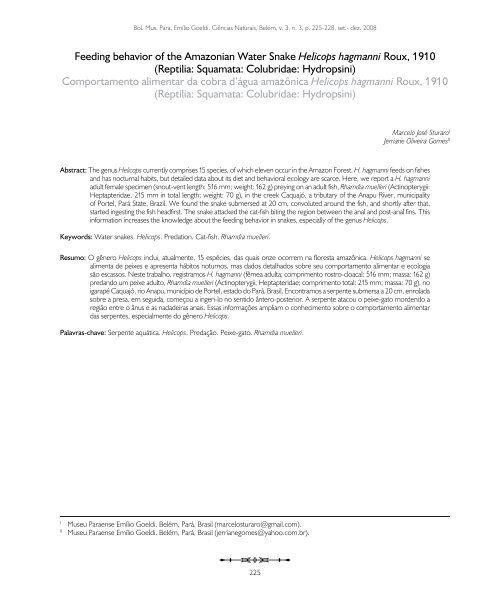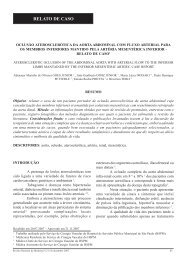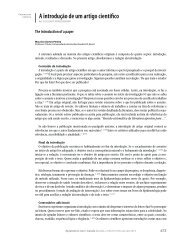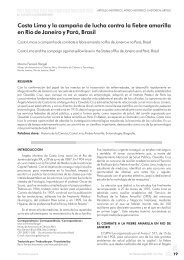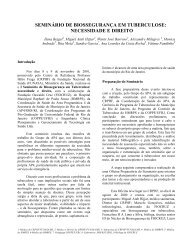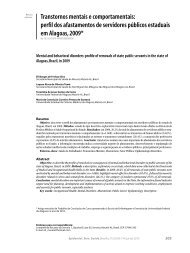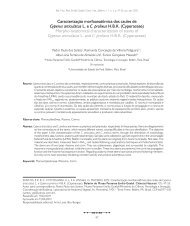Reptilia: Squamata: Colubridae: Hydropsini
Reptilia: Squamata: Colubridae: Hydropsini
Reptilia: Squamata: Colubridae: Hydropsini
Create successful ePaper yourself
Turn your PDF publications into a flip-book with our unique Google optimized e-Paper software.
Bol. Mus. Para. Emílio Goeldi. Ciências Naturais, Belém, v. 3, n. 3, p. 225-228, set.- dez. 2008<br />
Feeding behavior of the Amazonian Water Snake Helicops hagmanni Roux, 1910<br />
(<strong>Reptilia</strong>: <strong>Squamata</strong>: <strong>Colubridae</strong>: <strong>Hydropsini</strong>)<br />
Comportamento alimentar da cobra d’água amazônica Helicops hagmanni Roux, 1910<br />
(<strong>Reptilia</strong>: <strong>Squamata</strong>: <strong>Colubridae</strong>: <strong>Hydropsini</strong>)<br />
Marcelo José Sturaro I<br />
Jerriane Oliveira Gomes II<br />
Abstract: The genus Helicops currently comprises 15 species, of which eleven occur in the Amazon Forest. H. hagmanni feeds on fishes<br />
and has nocturnal habits, but detailed data about its diet and behavioral ecology are scarce. Here, we report a H. hagmanni<br />
adult female specimen (snout-vent length: 516 mm; weight: 162 g) preying on an adult fish, Rhamdia muelleri (Actinopterygii:<br />
Heptapteridae, 215 mm in total length; weight: 70 g), in the creek Caquajó, a tributary of the Anapu River, municipality<br />
of Portel, Pará State, Brazil. We found the snake submersed at 20 cm, convoluted around the fish, and shortly after that,<br />
started ingesting the fish headfirst. The snake attacked the cat-fish biting the region between the anal and post-anal fins. This<br />
information increases the knowledge about the feeding behavior in snakes, especially of the genus Helicops.<br />
Keywords: Water snakes. Helicops. Predation. Cat-fish. Rhamdia muelleri.<br />
Resumo: O gênero Helicops inclui, atualmente, 15 espécies, das quais onze ocorrem na floresta amazônica. Helicops hagmanni se<br />
alimenta de peixes e apresenta hábitos noturnos, mas dados detalhados sobre seu comportamento alimentar e ecologia<br />
são escassos. Neste trabalho, registramos H. hagmanni (fêmea adulta; comprimento rostro-cloacal: 516 mm; massa: 162 g)<br />
predando um peixe adulto, Rhamdia muelleri (Actinopterygii, Heptapteridae; comprimento total: 215 mm; massa: 70 g), no<br />
igarapé Caquajó, rio Anapu, município de Portel, estado do Pará, Brasil. Encontramos a serpente submersa a 20 cm, enrolada<br />
sobre a presa, em seguida, começou a ingeri-lo no sentido ântero-posterior. A serpente atacou o peixe-gato mordendo a<br />
região entre o ânus e as nadadeiras anais. Essas informações ampliam o conhecimento sobre o comportamento alimentar<br />
das serpentes, especialmente do gênero Helicops.<br />
Palavras-chave: Serpente aquática. Helicops. Predação. Peixe-gato. Rhamdia muelleri.<br />
I<br />
Museu Paraense Emílio Goeldi. Belém, Pará, Brasil (marcelosturaro@gmail.com).<br />
II<br />
Museu Paraense Emílio Goeldi. Belém, Pará, Brasil (jerrianegomes@yahoo.com.br).<br />
225
Feeding behavior of the Amazonian Water Snake Helicops hagmanni Roux, 1910 (<strong>Reptilia</strong>: <strong>Squamata</strong>: <strong>Colubridae</strong>: <strong>Hydropsini</strong>)<br />
The genus Helicops (<strong>Colubridae</strong>) comprises 15 species of water<br />
snakes distributed throughout cis-Andean South America, from<br />
Colombia to Argentina. Eleven of those species occur in the<br />
Amazonian rain forest (Rossman, 1970, 1973; Frota, 2005).<br />
Little is known about the ecology and natural history of Helicops<br />
species and the studies available are concentrated in few localities<br />
in Amazonia (Cunha & Nascimento, 1978; Duellman, 1978;<br />
Cunha & Nascimento, 1993; Silva Jr., 1993; Martins & Oliveira,<br />
1998), caatinga (Vanzolini et al., 1980), pantanal wetland (Ávila<br />
et al., 2006), Atlantic rain forest (Sazima & Strüssmann, 1990;<br />
Marques et al., 2004; Marques & Sazima, 2004), and southern<br />
Brazil (Araujo & Ely, 1980; Sazima & Martins, 1990; Aguiar &<br />
Di-Bernardo, 2004; Franz et al., 2007).<br />
Most Helicops species exhibit nocturnal habits,<br />
feed upon fishes, anuran tadpoles, and lizards (Cunha &<br />
Nascimento, 1978; Duellman, 1978; Vanzolini et al., 1980;<br />
Sazima & Martins, 1990; Sazima & Strüssmann, 1990;<br />
Cunha & Nascimento, 1993; Silva Jr., 1993; Martins &<br />
Oliveira, 1998; Marques et al., 2004; Marques & Sazima,<br />
2004; Ávila et al., 2006), but generally no details are<br />
provided about the predatory behaviour in relation to<br />
prey type (for example a fish with spines in its fins or not).<br />
Sazima & Strüssmann (1990) reported scavenging of H.<br />
modestus Günther, 1861 of Geophagus brasiliensis (Quoy<br />
& Gaimard, 1824) (Cichlidae) and Astyanax scabripinnis<br />
(Jenyns, 1842) (Characidae) in the field in southeastern<br />
Brazil. Lema et al. (1983) reported an event of cannibalism<br />
among newborn captive H. infrataeniatus Jan, 1865.<br />
Information on food and feeding behavior of<br />
Helicops hagmanni is scarce. This species feeds upon<br />
fishes and some authors suggested that it is primarily<br />
nocturnal (Cunha & Nascimento, 1978, 1993; Silva Jr.,<br />
1993; Martins & Oliveira, 1998). In this work, we present<br />
an observation of Helicops hagmanni preying on a cat-fish,<br />
Rhamdia muelleri (Günther, 1864), in the field.<br />
On September 9, 2007 at 2300h in the creek Caquajó<br />
(1º 57’ 36” S, 51º 36’ 55” W; 20 m a.s.l.) of the plot of Programa<br />
de Pesquisa em Biodiversidade (PPBio), Anapu River, Floresta<br />
Nacional de Caxiuanã, municipality of Portel, state of Pará,<br />
Brazil, we found an adult female Helicops hagmanni (516 mm<br />
snout-vent length and 162 g weight) submersed in water at<br />
a depth of 20 cm, which was preying on an adult cat-fish,<br />
Rhamdia muelleri (215 mm total length and 70 g weight).<br />
The snake seized the fish biting the prey’s posterior<br />
body between the anal and post-anal fins (mark of bite on the<br />
R. muelleri was observed after the capture), maybe avoiding<br />
the fish’s pectoral spines. After this, the snake held the prey<br />
with anterior, horizontal coils, similar to what has been<br />
observed in other colubrid snakes according to Willard (1977)<br />
(Figure 1A). Subsequently, the snake extended constriction<br />
until the opercula area of the cat-fish (Figure 1B).Thereafter,<br />
the snake examined the prey’s body and swallowed it (Figure<br />
1C), starting ingestion headfirst (Figure 1D). Aguiar & Di-<br />
Bernardo (2004) reported, based on fieldwork, that 92% of<br />
the proportionally large preys ingested by H. infrataeniatus<br />
(mainly adults) were oriented and swallowed headfirst.<br />
Greene (1997) pointed out that large preys or<br />
preys with a defensive apparatus (spines) require some<br />
maneuvering prior to swallowing. We concluded that H.<br />
hagmanni assessed the better way to swallow its prey, likely,<br />
due to ontogenetic learning, taking into account the presence<br />
of pectoral spines and the proportionally large size of the<br />
fish (Murphy & Campbell, 1987; Sazima & Martins, 1990).<br />
The pectoral spines could obstruct the ingestion if the prey<br />
was oriented tailfirst, which would result in damage of the<br />
digestive tract, causing lesion, and even leading to death<br />
(Aguiar & Di-Bernardo, 2004).<br />
More field observations on the feeding behavior of<br />
Helicops and other water snakes are needed to increase<br />
our knowledge about how these snakes capture and feed<br />
upon their preys.<br />
Both specimens have been deposited in the herpetological<br />
(MPEG 22403) and ichthyological (MPEG 13408) collections of<br />
the Museu Paraense Emílio Goeldi, Belém, Pará, Brazil.<br />
ACKNOWLEDGEMENTS<br />
We thank Marinus S. Hoogmoed and Wolmar B.<br />
Wosiacki for snake and fish species identification,<br />
226
Bol. Mus. Para. Emílio Goeldi. Ciências Naturais, Belém, v. 3, n. 3, p. 225-228, set.- dez. 2008<br />
Figure 1. Helicops hagmanni feeding on a Rhamdia muelleri in a tributary of the Anapu River, municipality of Portel, Pará State, Brazil. (A)<br />
The snake holding the cat-fish with anterior, horizontal coils. (B) The snake extending constriction until the opercula area of the cat-fish.<br />
(C) The snake examining the prey´s body. (D) The snake starting the ingestion headfirst.<br />
respectively. We also thank Adriano O. Maciel; Diogo<br />
B. Provete; Gleomar Maschio and Pedro Peloso for<br />
critically reading the manuscript. We also thank the<br />
Instituto Brasileiro do Meio Ambiente e dos Recursos<br />
Naturais Renováveis for the collecting and transport<br />
permits of snake (n o 02001.001490/2006-81) and fish (n o<br />
02001.001486/2006-12), and the Programa de Pesquisa<br />
em Biodiversidade (PPBio) for financial support of the<br />
expedition and for the provision of field structures.<br />
REFERENCES<br />
AGUIAR, L. F. S. & M. DI-BERNARDO, 2004. Diet and feeding<br />
behavior of Helicops infrataeniatus (Serpentes: <strong>Colubridae</strong>:<br />
Xenodontinae) in southern Brazil. Studies on Neotropical Fauna<br />
and Environment 39(1): 7-14.<br />
AraUjo, M. L & A. M. Ely, 1980. Incidência sazonal de Helicops<br />
carinicaudus (Jan, 1865) e Philodryas patagoniensis (Girard, 1857) no<br />
estado do Rio Grande do Sul, Brasil (Ophidia, <strong>Colubridae</strong>). Iheringia<br />
(série Zoologia) 55: 87-106.<br />
Ávila, R. W., V. L. ferreira & J. O. Arruda, 2006. Natural<br />
history of the South American water snake Helicops leopardinus<br />
(<strong>Colubridae</strong>: <strong>Hydropsini</strong>) in the Pantanal, Central Brazil. Journal of<br />
Herpetology 40(2): 274-279.<br />
cunha, O. R. & F. P. Nascimento, 1993. Ofídios da Amazônia:<br />
as cobras da região leste do Pará. Boletim do Museu Paraense<br />
Emílio Goeldi, série Zoologia 9(1): 1-191.<br />
cunha, O. r. & F. P. Nascimento, 1978. Ofídios da Amazônia<br />
X: as cobras da região leste do Pará. Publicações Avulsas do Museu<br />
Paraense Emílio Goeldi 31: 1-218.<br />
Duellman, W. E., 1978. The biology of an equatorial herpetofauna<br />
in Amazonian Ecuador. Miscellaneous Publication of the Museum<br />
of Natural History, The University of Kansas 65: 1-352.<br />
227
Feeding behavior of the Amazonian Water Snake Helicops hagmanni Roux, 1910 (<strong>Reptilia</strong>: <strong>Squamata</strong>: <strong>Colubridae</strong>: <strong>Hydropsini</strong>)<br />
Franz, I., I. R. G. Ghizoni-Jr, J. L. B. Albuquerque,<br />
A. Barcellos, C. B. Hassdenteufel, F. B. Arend & C.<br />
Martins-Ferreira, 2007. Predação da cobra d’água Helicops<br />
infrataeniatus (Serpentes, <strong>Colubridae</strong>) pela maria-faceira Syrigma<br />
sibilatrix (Aves, Ardeidae) no sul do Brasil. Biotemas 20(2): 135-137.<br />
Frota, J. G., 2005. Nova espécie de Helicops Wagler, 1830<br />
(Serpentes, <strong>Colubridae</strong>) do rio Tapajós, Amazônia, Brasil.<br />
Phyllomedusa 4(1): 61-68.<br />
Greene, H. W., 1997. Snakes, the evolution of mystery in nature:<br />
1-351. University of California Press, Berkeley.<br />
Lema, T., M. L. Araújo & A. Azevedo, 1983. Contribuição ao<br />
conhecimento da alimentação e do modo alimentar de serpentes<br />
do Brasil. Comunicação do Museu de Ciência e Tecnologia da<br />
Pontifícia Universidade Católica do Rio Grande do Sul, Série<br />
Zoologia 26: 41-121.<br />
Marques, O. A. V. & I. Sazima, 2004. História natural dos répteis<br />
da Estação Ecológica Juréia-Itatins. In: O. A. V. Marques & W.<br />
Duleba (Eds.): Estação Ecológica Juréia-Itatins: ambiente físico,<br />
flora e fauna: 257-277. Holos, Ribeirão Preto.<br />
Marques, O. A. V., A. Eterovic & I. Sazima, 2004. Snakes of<br />
the Brazilian atlantic forest: An illustrated field guide for the Serra<br />
do mar range: 1-205. Holos, Ribeirão Preto.<br />
Martins, M. & M. E. Oliveira, 1998. Natural history of<br />
snakes in forest of the Manaus region, Central Amazonia, Brazil.<br />
Herpetological Natural History 6(2): 78-150.<br />
MURPHY, J. B. & J. A. CAMPBELL, 1987. Captive maintenance.<br />
In: R. A. SEIGEL, J. T. COLLINS & S. S. NOVAK: Snakes:<br />
ecology and evolutionary biology: 165-181. Macmillan Publishing<br />
Company, New York.<br />
ROSSMAN, D. A., 1973. Miscellaneous notes on the South American<br />
water snake genus Helicops. HISS News-Journal 1: 189-191.<br />
Rossman, D. A., 1970. Helicops Wagler. In: J. A. PETERS &<br />
B. OREJAS-MIRANDA: Catalogue of the neotropical <strong>Squamata</strong>:<br />
Part I, Snakes: 122-125. Bulletin of United States National<br />
Museum 297: 1-346.<br />
SAZIMA, I. & M. MARTINS, 1990. Presas grandes e serpentes<br />
jovens: quando os olhos são maiores que a boca. Memórias do<br />
Instituto Butantan 52(3): 73-79.<br />
Sazima, I. & C. strüssmann, 1990. Necrofagia em serpentes<br />
brasileiras: exemplos e previsões. Revista Brasileira de Biologia<br />
50(2): 463-468.<br />
Silva Jr., n. j., 1993. The snakes from Samuel hydroelectric<br />
power plant and vicinity, Rondônia, Brazil. Herpetological Natural<br />
History 1: 37-66.<br />
Vanzolini, P. E., A. M. M. Ramos-Costa & L. J. Vitt, 1980.<br />
Répteis das Caatingas: 1-161. Academia Brasileira de Ciências, Rio<br />
de Janeiro.<br />
Willard, D. E., 1977. Constricting methods of snakes. Copeia<br />
1977: 379-382.<br />
Recebido: 20/10/2008<br />
Aprovado: 28/12/2008<br />
228


